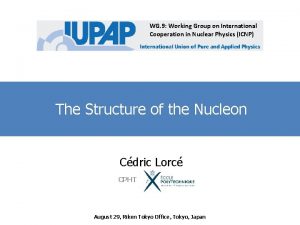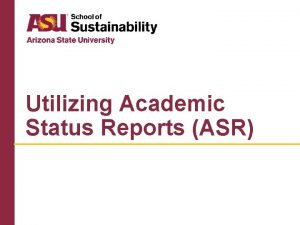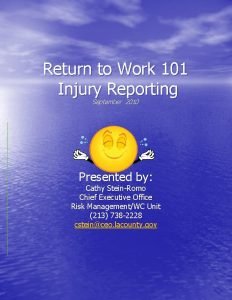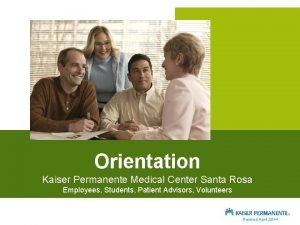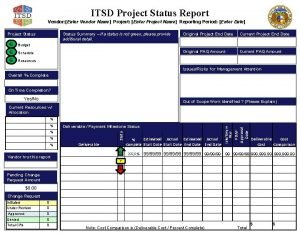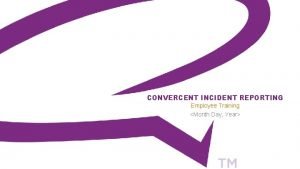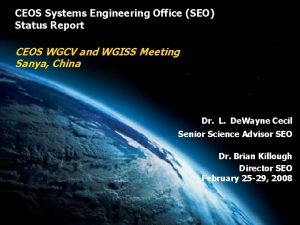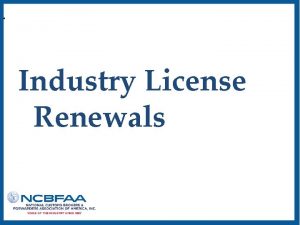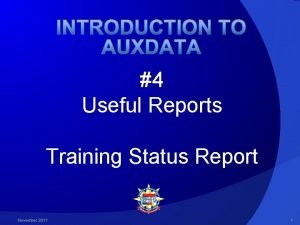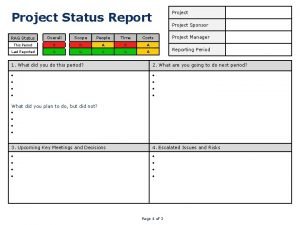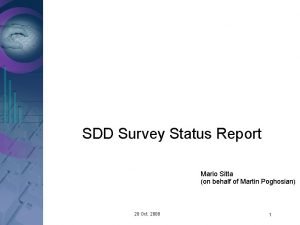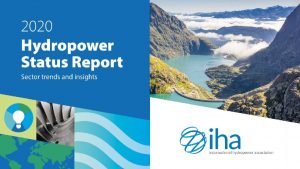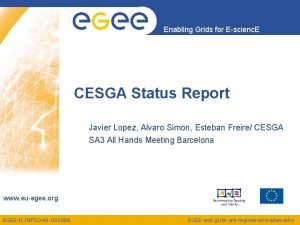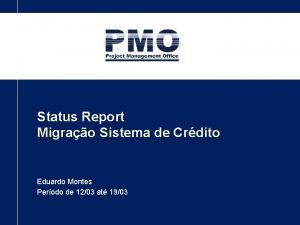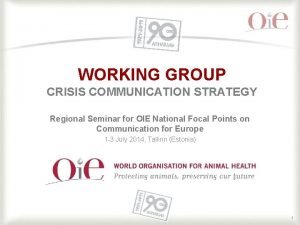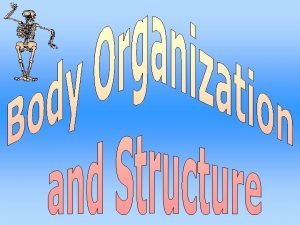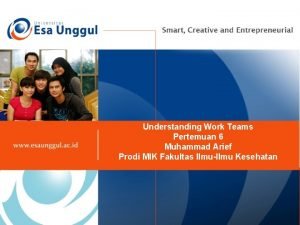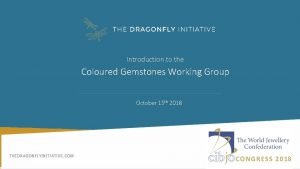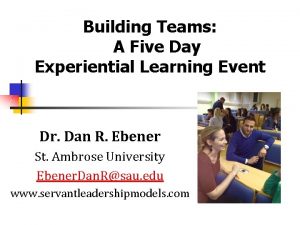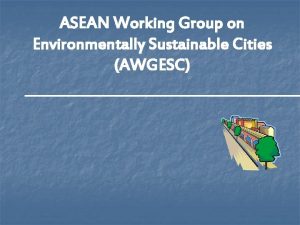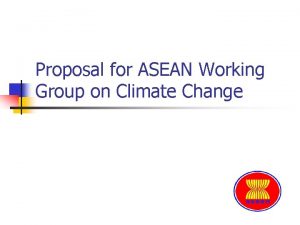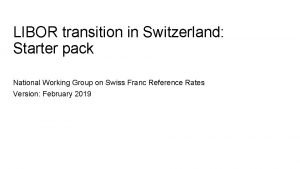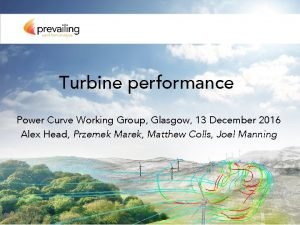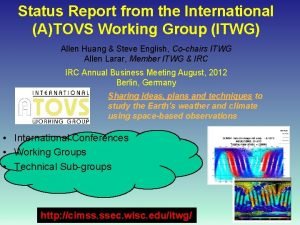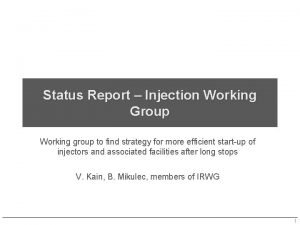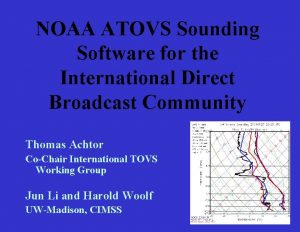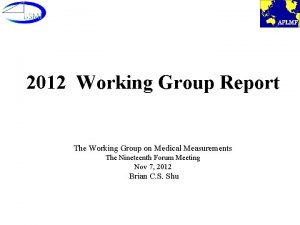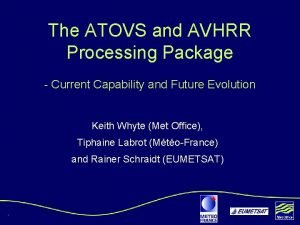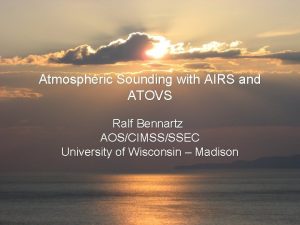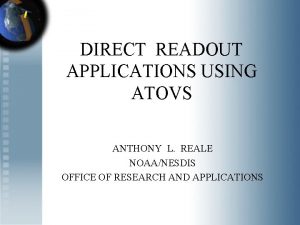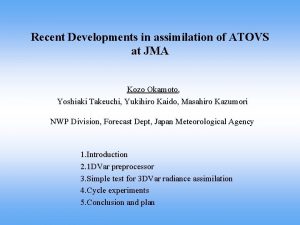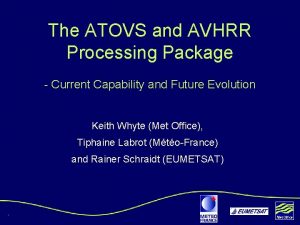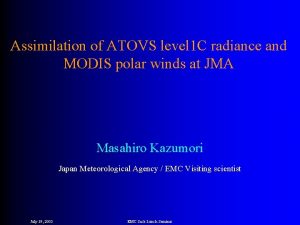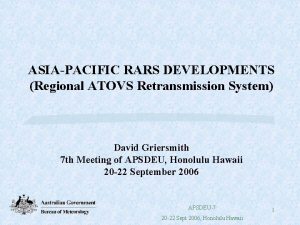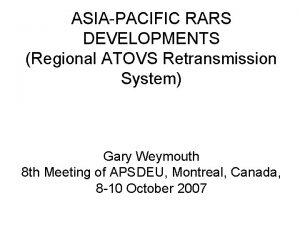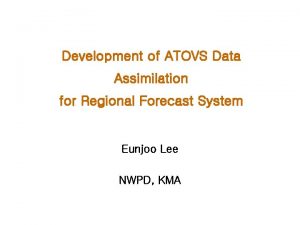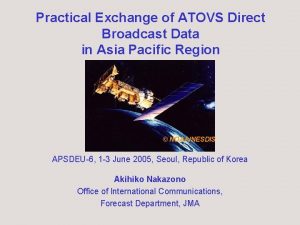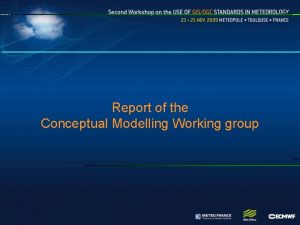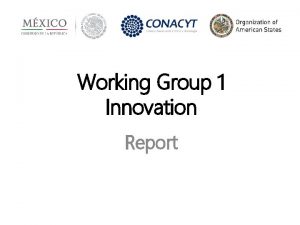Status Report from the International ATOVS Working Group






























- Slides: 30

Status Report from the International (A)TOVS Working Group (ITWG) Allen Huang & Steve English, Co-chairs ITWG Allen Larar, Member ITWG & IRC Annual Business Meeting (7/24/09) Montreal, Canada Sharing ideas, plans and techniques to study the Earth’s weather and climate using space-based observations • International Conferences • Working Groups • Technical Sub-groups http: //cimss. ssec. wisc. edu/itwg/ 1

ITWG Status Report—Topics • ITWG Overview – Mission, membership, structure, heritage • ITSC-16 Summary – Presentations, conclusions, actions & recommendations • Way Forward – Activities since ITSC-16 – Future plans 2

ITWG Mission The ITWG serves as a forum for operational and research users of TIROS Operational Vertical Sounder (TOVS), Advanced TOVS (ATOVS), and other advanced atmospheric sounding data to exchange ideas on methods for extracting information from these data to create atmospheric variables, and on usage / impact of these data and products in numerical weather prediction and in climate studies. ITWG organizes the International TOVS Study Conferences (ITSCs), which have met every 18 -24 months since 1983. 3

ITWG Mission - continued The ITWG meetings result in recommendations and actions to guide the directions of future research and to influence relevant programs of the WMO and satellite provider agencies (e. g. NASA, NOAA, EUMETSAT, NSMC, JMA, ISRO, …). An important part of the group's work has been to foster and participate in the generation of software to be shared throughout the community to enable use to be made of these data for operations and research. The group is also developing an important education and training role through the WMO and other collaborative and member actions. 4

ITWG Co-Chairs • ITSC 1 -3 Bill Smith Univ. Wisconsin Rolando Rizzi Univ. Alain Chedin LMD Paul Menzel Bologna • ITSC 4 -6 NOAA • ITSC 7 -9 John Eyre UK Met Office Mike Uddstrom NIWA • ITSC 10 -12 Guy Rochard Meteo-France John Le. Marshall ABo. M • ITSC 13 -15 Roger Saunders UK Met Office Tom Achtor Univ. Wisconsin • ITSC 16 -18 Allen Huang* Univ. Wisconsin Steve English* UK Met 5

ITWG Members are located worldwide ITSC-16, Angra dos Reis, Brazil: 130 participants from 19 countries WMO, NOAA, NASA, ECMWF EUMETSAT, CMA, JMA, ISRO CPTEC/INPE, ABOM, Meteo France, UK Met. Off, LMD, CWB, NIWA, Universities …. ITSC-15, Maratea, Italy: 110 participants from 16 countries 6

ITWG Working Groups & Technical Sub-Groups Working Groups: • • • Advanced Sounders ATOVS/TOVS data in NWP ATOVS/TOVS in climate studies International Issues and Future Systems Radiative transfer and surface property modeling Satellite Sounder Science and Products Technical Sub-Groups: • • • ATOVS and AVHRR Processing Package International ATOVS Processing Package International MODIS/AIRS Processing Package Fast Radiative Transfer Model, RTTOV Community Radiative Transfer Model Frequency Management 7

ITSC 1 -17 Locations ☻ ITSC-15 ITSC-17 ITSC-16 1 st Meeting in Igls, Austria – August 1983 Europe (8), NAM (5), Asia/Oceania (3), SAM (1) 8

9

Tribute to Izabela Dyras held during ITSC-16 The conference paid tribute to Izabela Dyras, an active member of the group, who died in 2007. During the conference banquet on Itanhanga Island, Bozena Lapeta, Paolo Antonelli and Tom Achtor recalled Izabela’s life and her contribution both to ITWG and to the development and use of satellite data in Poland. She will be sadly missed by the ITWG. 10

ITSC-16 Science Presentations • Radiative transfer and surface modeling • Climate applications • ATOVS cloud studies • Direct broadcast software, preprocessing and calibration and frequency protection (again dedicated to Guy Rochard) • IASI • Operational use of ATOVS • Developments in use of ATOVS in NWP • International Issues and Agency Status Reports • Products from ATOVS • Future sensors 11

ITWG Special Focus Working Groups Reports provided by each group 1. Use of TOVS/ATOVS in Data Assimilation and Numerical Weather Prediction 2. Satellite Sounder Science and Products 3. Radiative Transfer and Surface Property Modeling 4. Use of TOVS/ATOVS Data in Climate Studies 5. Advanced Sounders 6. International Issues and Future Systems 12

ITSC-16 Major Conclusions (1/8) 1. The group noted that LEO IR and MW sounding capability on 3 orbital planes is essential to proper sampling of atmospheric temperature and humidity vertical profiles. At present there is no IR sounding capability planned for the early morning orbit and the performance of the MIS sounding channels is yet to be assessed. The group recommended WMO, CGMS and CEOS investigate scenarios for sounding instruments in the early morning orbit. 1. The results of new observing system experiments presented at ITSCXVI demonstrate that satellite data have a large impact on weather forecast accuracy and promising new results suggest the potential for future enhancements in the use of satellite sounder and imager data. It is crucial that future instruments as a baseline maintain, and if cost effective, improve upon the quality of AMSU and IASI. 1. Many NWP centres are now assimilating radiances operationally or experimentally from the Infrared Atmospheric Sounding Interferometer (IASI), and getting significant positive forecast impacts. The experience with AIRS was crucial to the rapid implementation of IASI. 13

ITSC-16 Major Conclusions (2/8) 4. The Regional ATOVS Retransmission Service, RARS, has continued to develop since ITSC-XV. The Asia-Pacific RARS service has continued to expand more NWP centres are using the RARS data. RARS networks in S. America and Africa are now available. The group encouraged WMO and the space agencies to continue to develop this ATOVS retransmission service as a low cost means of providing more timely ATOVS data for 90% of the globe. The Southern Ocean and North Pacific were identified by one study as particularly needing RARS. 5. The group continues to strongly support the Safety. Net concept, which will allow rapid dissemination of global NPOESS data products, identifying it as one of the most attractive features of NPOESS. WMO and the RARS Implementation Group were invited to consider an expansion of RARS for NPP and NPOESS-C 1 as Safety. Net will become fully operational only from NPOESS-C 2 onwards. 6. An important issue for consideration is that when MODIS is retired, according to current plans, there will not be an imager in polar orbit with a channel in the water vapour band. This will degrade the accuracy of any polar satellite derived winds. Space agencies are urged to consider the best means for providing a polar orbiting imager with water vapour channels along with the conventional VIS and IR channels. 14

ITSC-16 Major Conclusions (3/8) 7. Further progress in the pre-processing of SSMIS data has been made with the development of the unified preprocessor, jointly developed by several centres with a strong interest in SSMIS data quality. More NWP centres are now able to use the DMSP-F 16 SSMIS sounding channels operationally and progress is being made with DMSP-F 17 SSMIS. The group encouraged the SSMIS cal/val team to make the data available from DMSP-F 18 as early as possible after the launch to expedite their use in operational systems. 8. The group urged space agencies to use expertise from NWP centres thoughout the cal/val phase for new instruments, as proved particularly successful for SSMIS and IASI. 9. The group encouraged the careful characterization of new satellite instruments, notably promoting the use of pre- and post-launch traceable calibration standards for future sounders. 10. The group noted that lossy datasets for advanced sounders may not be suitable for all applications and consequently recommended techniques for spatial as well as spectral thinning to be studied for distribution of 15 advanced sounder data, notably IASI.

ITSC-16 Major Conclusions (4/8) 11. The community software packages (i. e. AAPP, IMAPP) have been essential in the use of ATOVS, IASI, AIRS and MODIS data by the meteorological community. The group encouraged satellite agencies to continue to support these packages for existing missions and to develop and release pre-processing software packages (e. g. IPOPP) as soon as practical before launch. 12. The group urged space agencies to provide documentation on data formats well before launch to allow similar community software packages to be developed for planned new satellites (e. g. FY-3 and NPP). 13. The group noted the increasing threat of RF interference in microwave imager channels. All members were urged to lobby their respective radio communication authorities to support protection of the imager and sounder bands and specifically to identify useful bands between 275 and 3000 GHz and to undertake more detailed studies in support of 52. 6 -59. 3 GHz and 86 -92 GHz. 14. Satellite agencies were again encouraged to continue and expand their support for education and training of the next generation of remote 16 sensing scientists.

ITSC-16 Major Conclusions (5/8) 15. It was also noted that research into truly lossless compression techniques continues in the wider scientific community. It is recommended that space agencies investigate both lossless and lossy data compression techniques which may be used to aid dissemination of advanced sounder observations. 16. Optimal use of community state-of-art software packages within the central operational processing for satellite programs has been raised again and the group is continuing to recommend to the space agencies to promote partnership in building environmental satellite systems where government, industry and university science communities share their expertise. 17. The time series of (A)TOVS now exceeds 29 years and the quality and number of climate products continues to grow. It was recognized that the fundamental instrument parameters of all the (A)TOVS sensors should be retained for future reprocessing efforts. 17

ITSC-16 Major Conclusions (6/8) 18. The group supported the continuing efforts to develop the GCOS Reference Upper Atmospheric Network (GRUAN) for climate with the primary objective of creating long term records of critical upper air measurements and associated error characteristics to support their continuing integration in climate applications and research. 19. The ITWG noted that the TOVS/ATOVS lower tropospheric climate data record is view geometry dependent and this product would be lost if there was a migration to a conical viewing geometry. 20. It was recognised that hyperspectral resolution imaging radiometers on geostationary platforms are likely to be an important part of the future global observing system. The group supported plans for operational missions but would also welcome a preparatory mission earlier than 2015 if possible. 21. The group noted that GPSRO data have allowed better characterization of biases in passive sounding data from 20 -40 km and consequently operational continuity for COSMIC is now important to maintaining good quality passive upper level sounding 18 data.

ITSC-16 Major Conclusions (7/8) 22. The success of the JAIVEx campaign in support of cal/val for IASI was reported at ITSC-XVI both in support of assimilation of IASI observations in NWP and to improve characterization of climate data records. The group urged similar campaigns for future instruments. 23. Many centres are experiencing difficulty using moisture-sensitive channels and the group urged more focused effort in this area and encouraged more exchanges of experience between centres. 24. Since ITSC-XV several centres have made significant progress in understanding and using cloud-affected radiances, with progress in radiative transfer, data assimilation and more sophisticated cloud screening. As a result more satellite sounding data can be used. 25. The IASI and AIRS radiances assimilated are still a small fraction of those available but some efforts are underway to allow a more complete use of the data (e. g. through use of reconstructed radiances or principal components). 19

ITSC-16 Major Conclusions (8/8) 26. The number of NWP centres using level 1 b ATOVS radiances in their variational data assimilation systems continues to grow but there are still centres which rely on the level 2 retrievals provided by NESDIS. 27. The group recommended further studies on the optimization of the size of the advanced sounder fields of view using experience with the Met. Op HIRS/4 and NOAA-17 HIRS/3 instruments. 20

ITSC-16 Actions & Recommendations (1/3) RADIATIVE TRANSFER AND SURFACE PROPERTY MODELLING 27 Actions 4 Recommendations TOVS/ATOVS IN CLIMATE 11 Actions 17 Recommendations THE USE OF TOVS/ATOVS IN DATA ASSIMILATION/ NUMERICAL WEATHER PREDICTION 16 Actions 9 Recommendations DIRECT BROADCAST 5 Actions 21

ITSC-16 Actions & Recommendations (2/3) ADVANCED SOUNDER 8 Actions 35 Recommendations INTERNATIONAL ISSUES AND FUTURE SYSTEMS 8 Actions 10 Recommendations SATELLITE SOUNDER SCIENCE AND PRODUCTS 12 Actions 1 Recommendation FREQUENCY MANAGEMENT 4 Actions 1 Recommendation 22

ITSC-16 Actions & Recommendations (3/3) Total of 91 Actions And 77 Recommendations Too numerous to cover here, see complete list and entire final report at: http: //cimss. ssec. wisc. edu/itwg/itsc 16/report/WGR_final_indexed. pdf 23

Activities since ITSC-16 (1/2) 1. Next ITWG meeting, ITSC-17 is planned to take place in April 2010 and be hosted by Nancy Baker of Naval Research Lab. of United States. 2. The 4 th Hyperspectral Workshop was held at EUMETSAT, Darmstadt, Germany 15 -17 th September 2008. ITWG undertook to assist coordination between this group, the AIRS science team, the IASI conference and the ITWG advanced sounder working group to ensure effective exchange of information. 3. The ITWG also held the second workshop on remote sensing and modeling of surface properties in June 2009 (Toulouse, France). 24

Activities since ITSC-16 (2/2) 4. In addition to ITSC-XVI Working Group Report, a Proceedings for ITSC-XVI from the papers submitted are provided to attendees and other interested persons on CD-ROM. The oral and poster presentations from ITSC-XVI are already available as pdf files which can be downloaded from the ITWG web site. 25

ITWG Future Plans (1/2) 1. The ITWG will continue to meet and inform the ATOVS and advanced sounder community of the latest news and developments through its Web site currently maintained by the University of Wisconsin CIMSS and the email list also maintained by CIMSS. 2. The website will continue to evolve to become an even more important tool for ITSC, with many new ideas proposed and endorsed at ITSC-16. This could include some interactive elements to the website (e. g. , wiki). 26

ITWG Future Plans (2/2) 3. The format of ITSC-16 was similar to previous meetings, but with a significant increase in numbers attending resulting in significant time pressure on the agenda. If the recommendation of the climate working group to attract significantly more climate scientists to ITSC-17 is successfully carried out, the climate session will have to be significantly longer. Therefore ITWG has to consider options for continuing to deliver a successful meeting which may require changes in structure, length or number of oral presentations. At ITSC-16 a partially successful experiment was carried out with the operational NWP session using a format of a longer, invited summary presentation, followed by short 3 -minute poster presentations, followed by the poster session. It has been suggested this format could be extended to other sessions, e. g. , the agency status reports and reports on software packages. The ITWG members expressed a strong preference to investigate this type of option before any move to parallel sessions is considered. 27

ITWG Next Meeting: ITSC-17 Monterey, California, USA from Wednesday 14 April through Tuesday 20 April 2010 The ITSC-17 will be hosted by the Naval Research Laboratory located in Monterey, California, USA. Nancy Baker and Benjamin Ruston are the gracious local hosts of our next meeting. The conference location will be at the Asilomar Conference Grounds (http: //www. visitasilomar. com/). 28

ITSC-17 Topics to be considered • Updates on operational processing and the exploitation of ATOVS, SSMIS and hyperspectral sounder data • New applications of ATOVS, SSMIS and hyperspectral sounder data in numerical weather prediction and nowcasting (e. g. new assimilation techniques, bias tuning, use of cloudy radiances) • Use of ATOVS, SSMIS and hyperspectral sounder data over land ice surfaces • Generation of geophysical parameters with emphasis on surface emissivity, cloud, and precipitation • Applications of ATOVS, SSMIS and hyperspectral data in climate monitoring, direct broadcast and GCOS activities. • Direct readout software and its real time applications • New results from Aqua AIRS, AMSU, MODIS, METOP ATOVS and IASI sounders, and FY 3 microwave and infrared sounders. • Studies and results for new and future infrared and microwave sounders. Examples include Cr. IS, ATMS, MIS, FY instruments, geostationary hyperspectral sounders (MTG-IRS, GIFTS, GOES next generation hyperspectral sounder), and other innovative advanced 29 sounding instruments.

ITSC-16 Proceedings 430 pages, including: 1: Guy Rochard session on direct broadcast packages, preprocessing, calibration and frequency protection 2: The Infrared Atmospheric Sounding Interferometer 3: Atmospheric radiative transfer 4: Surface emission and scattering 5: Climate Studies 6: Current use in NWP 7: Developments in use of sounding data in NWP and Environmental Prediction 8: Cloud Studies 9: Developments in assimilation of sounding data in NWP in cloud regions 10: Other applications of sounder data And papers from posters http: //cimss. ssec. wisc. edu/itwg 30
 Project progress status
Project progress status Working group on international cooperation
Working group on international cooperation Working hard vs working smart
Working hard vs working smart Hot working of metal is
Hot working of metal is Hot working and cold working difference
Hot working and cold working difference Differentiate between hot working and cold working
Differentiate between hot working and cold working Proses pembentukan logam
Proses pembentukan logam Academic status report asu
Academic status report asu Work status report from doctor
Work status report from doctor Kaiser code gray
Kaiser code gray Enter vendor name
Enter vendor name Convercent report status
Convercent report status Seo status report
Seo status report Customs broker triennial status report 2021
Customs broker triennial status report 2021 Training status report
Training status report Project overall status
Project overall status Annual status of education report
Annual status of education report Vertical mario
Vertical mario 2020 hydropower status report
2020 hydropower status report Status report
Status report Migrao
Migrao Crisis communication working group
Crisis communication working group Oecd working group on bribery
Oecd working group on bribery Cells working together form
Cells working together form Turning individuals into team players
Turning individuals into team players Coloured gemstones working group archives
Coloured gemstones working group archives Team vs group
Team vs group Awgesc asean
Awgesc asean Awgcc
Awgcc Switzerland starter pack
Switzerland starter pack Power curve working group
Power curve working group

